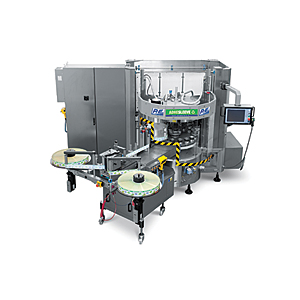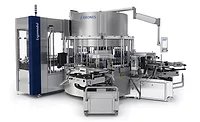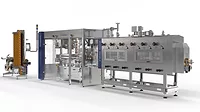Labeling equipment speeds ahead
Machinery meets new demands
According to a recent report by the Packaging Machinery Manufacturers Institute (PMMI), the market for labels is increasing year-over-year by as much as 5.2 percent. The “Trends In Labeling: Solutions Providers Wanted” report also states that U.S. label shipments will increase 4.2 percent annually and worldwide label shipments will increase 5.2 percent annually, reaching $20 billion and $110 billion, respectively, in 2015.

|
| P.E. USA Labeling Systems, a division of P.E. Labellers, offers its Adhesleeve labeler, which uses white or clear pre-glued roll-fed films with the ability to label mil thickness lower than the films normally used on classic roll-fed labelers, it says. |
With this increased demand for labels, beverage companies are looking for labeling equipment that is versatile, sustainable, and that enables their products to stand out on the shelf.
All-in-one
Real estate in many bottling plants is at a premium. As a result, companies are consistently looking for ways to increase efficiency and decrease costs.
“As companies grow, they want higher speeds and more efficiency, but they don’t always have the space to expand physically, so the real estate on a bottling line is very precious,” says Dave Niemuth, division director of labeling for Krones Inc., Franklin, Wis.
Therefore, to meet these demands, companies have been introducing more versatile and modular equipment.
“As with so many other types of machinery, versatility is in high demand,” said Paula Feldman, director of business intelligence for PMMI, in a statement. “Product manufacturers have to accommodate a variety of label technologies and materials, [and] a machine that can accommodate several functions will contribute to greater productivity and take up less space on the plant floor.”
Krones Inc.’s latest versatile solution to overcome space restrictions is the DecoBloc, a modular device that incorporates the company’s servo-drive technology and features various possible label applications, including pressure-sensitive, roll-fed, cut-and-stack using hot melt or wet glue, shrink and stretch. Each bottle plate is fitted with its own servo drive, which is electrically connected to the main drive. The bottle rotations required for rolling on the labels also are conducted according to a set program, which enables beverage companies to carry out cold glue labeling, roll-fed hot melt labeling and pressure-sensitive labeling on a single container table, the company states. Additionally, the machine can implement a complete product changeover in less than 30 minutes, which reduces the typical changeover time by 50 percent, it adds.
Sidel Group also believes that modular labeling equipment is on the rise. “Modular equipment is becoming a big trend [because] the same machine is able to manage different label typologies,” says Raffaele Pace, labeling product manager for the Switzerland-based company. For example, the company’s SL 90 rotary modular labeler can switch from a pressure-sensitive self-adhesive to cold-glue paper label station application.
“What makes the SL 90 such a unique machine on the market is its core: the carousel and the parts involved in transferring the containers — starwheels and screw feed — which have no gears and no contact,” the company says.
Because of this, the precision of the label application is optimized, maintenance costs are reduced by 20 percent, and there is a natural increase in efficiency, it adds.
Besides being versatile, it’s crucial for beverage companies that their modular equipment is flexible. As a result, P.E. Labellers, Cincinnati, introduced its Modular Plus equipment that helps users decide which labeling station to install, when to install it and whether to install labeling units as fixed or modular fittings, the company says. The machine can be integrated with optical spotting systems and cameras in order to allow companies the possibility of labeling different types of containers. After the machine has been purchased, it also is possible to replace existing labeling units with other fittings, which provides further flexibility for future labeling.
Standing out from the crowd
In addition to equipment that is versatile and efficient, beverage companies also need their labels to make an impact on the shelf. Krones’ Niemuth notes that the average consumer only takes 3.5 seconds to make a purchasing decision. Because of this, marketers want to make sure that their bottles make their mark.
“Today in North America, there is a major transformation of product decoration in order to attract the consumer, especially in the beverage industry,” Sidel’s Pace says. “The product needs to pop out on the shelf, [and] the shape and color need to be different than the standard product that everyone knows.”
To accomplish this, more beverage manufacturers are turning to shrink sleeve labels. “There is a growing trend in shrink sleeves due to less packaging restrictions and flexibility for new brand establishment, [which] has increased its use as a labeling solution,” says Raul Matos, vice president of sales and marketing for Karlville Development Group, Miami.
The company’s SleevePro 600 is its most popular machine within large beverage companies. The automatic shrink sleeve applicator uses advanced bullet technology, which precisely shoots the sleeve to the container, and is capable of running at speeds from 200 to 600 sleeves a minute. Six rotary blades simultaneously cut the sleeves, and the machine can be adapted with four different cutting units, depending on the width of the sleeves. For small- to medium-size beverage companies that require cost-effective solutions to run at lower speeds, Karlville also offers the SP150, which operates at 150 sleeves a minute.
Krones’ Niemuth also thinks that shaped containers are one of the most effective ways to grab consumers’ attention. “More than 50 percent of all beverage containers that are sold do no advertising, so this shrink label is their commercial. This is how they grab the consumer’s attention — by shape and color.”
The company specifically uses its Sleevematic, which applies a full-body shrink sleeve that can go either over the cap for a tamper-evident label or starting underneath the neck ring all the way down to the heel of the bottle, which allows for more advertising space. After the sleeve is put on the specific bottle, it enters a steam tunnel, which allows the sleeve to shrink as much as 70 to 80 percent, Niemuth says.
Sustainable efforts
Sustainability is one of the top trends in labeling equipment today. Beverage companies are looking for their bottles to be thinner and more eco-friendly, according to experts. As a result, it is crucial for labeling equipment to accommodate these demands.
Krones’ Sleevematic Enhanced Stretch (ES) applies low-density polyethylene stretch sleeves. The footprint of the label itself, according to Niemuth, is much smaller than a shrink sleeve label, which also has good recycling properties and can improve the carbon dioxide balance. It also is cost effective, he adds. The label technology also does not require a steam tunnel, which can help save energy, the company says.
“The factor of sustainability is very important in labeling, especially in shrink sleeve labeling,” Sidel’s Pace notes.
One of Sidel’s most eco-friendly solutions is its Rollsleeve Labeler, which is a two-in-one solution that switches between shrink-sleeve labels for shaped containers and classic hot-melt applications. The machines use rotary labelers that create and apply plastic shrink sleeves from a machine label roll onto glass, plastic or metal containers. Because the shrink sleeves are created and applied with a lengthways reel, they are closed without glues or solvents, making them 100 percent recyclable, the company says.
“In today’s market, the environment is an important part of production, and any time you can eliminate the need for hot-melt glue, this is a plus,” says Tom Kauffmann, vice president of sales for P.E. USA Labeling Systems, a division of P.E. Labellers.
The company offers its Adhesleeve labeler, which uses white or clear pre-glued roll-fed films with the ability to label mil thickness lower than the films normally used on classic roll-fed labelers. Because the linerless labeler eliminates the need for hot melt glue, it also eliminates the toxic fumes that typically emit from heating the glue, as well as the chemicals that are used to clean up the glue. Additionally, it is 100 percent recyclable, according to the company. “The P.E. Adhesleeve labeling system provides a clean environment [and] the ability for reduced roll-fed material, which equals greater efficiency for the respective plant, and more importantly, respects our environment without sacrificing labeling performance,” Kauffmann adds.
On the horizon
In the next three to five years, PMMI reports that there are six trends on the edge of changing labeling processes. These include: reductions in label unit costs, thinner label stock, reduced label material waste, greater use of sustainable materials, implementation of anti-counterfeiting and tamper-evident tactics, and improved tracking across the supply chain.
The beverage industry also will continue to demand higher speeds and quicker changeovers; however, it is crucial that manufacturers do not sacrifice precision or accuracy for speed, experts say.
“[We continually ask ourselves]: what can we do to increase our speeds but not lose efficiency along the way?” Krones’ Niemuth says.
To accomplish this, Krones is including more servo-technology, easy on-and-off change parts, and quick-release change parts.
Karlville also is developing a new shrink sleeve application that will allow beverage companies to run at speeds from 650 to 750 sleeves a minute.
In its “Trends in Labeling” report, PMMI stated that rapid-fire changes in labeling technologies are making customers eager for new solutions and guidance from suppliers.
“Seventy percent of the companies we interviewed are making some sort of change to their labeling, marking or coding processes,” PMMI’s Feldman said in a statement. “What they want is for their suppliers and original equipment manufacturers to help them implement the changes seamlessly.”
As a result, it is critical that equipment manufacturers not only are paying attention to the trends in their own industry, but also listening to the customer’s needs. BI
Looking for a reprint of this article?
From high-res PDFs to custom plaques, order your copy today!





